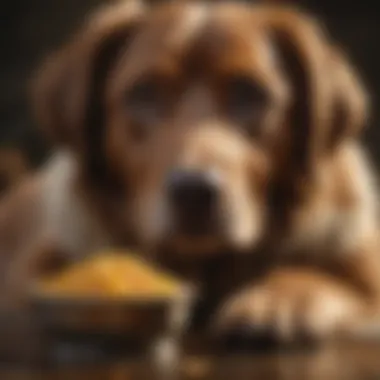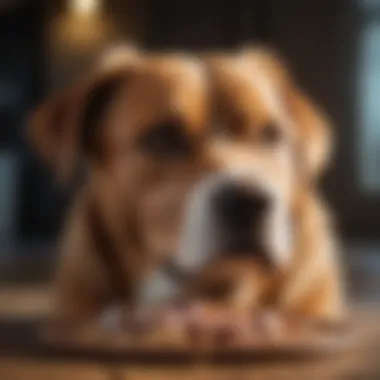Essential Feeding Guide for Dogs with Diarrhea


Intro
Dealing with canine diarrhea is a concern that many dog owners face at some point. Understanding what to feed a dog during this distressing situation is crucial for their recovery. Proper nutrition can help restore balance in the digestive system and support overall health. In this guide, we will explore the key aspects of feeding a dog experiencing diarrhea, including recommended ingredients and dietary adjustments.
Understanding Your Pet
Breed Traits
Different dog breeds may have varying responses to gastrointestinal issues. For instance, toy breeds might suffer from digestive disturbances more frequently than larger breeds. Understanding the specific traits of your dog's breed can be beneficial in providing appropriate care during episodes of diarrhea.
Common Temperaments
The temperament of your dog can influence how they react to illness. Some dogs may become more anxious or irritable when unwell. Being aware of their typical behavior helps you monitor changes and adjust their care if necessary. A calm environment and attention are key to easing stress during recovery.
Special Needs
Certain breeds or individual dogs may have specific dietary needs that affect their recovery. Dogs with sensitive stomachs or pre-existing conditions may require a specialized diet or therapeutic food. Consult with your veterinarian to tailor a plan that suits your dog's unique requirements.
Nutritional Considerations for Diarrhea
Nutrition and Feeding Guidelines
When a dog has diarrhea, it's essential to focus on easily digestible foods. Options like plain boiled chicken and white rice are gentle on the stomach. Additionally, reducing portion sizes can help prevent further irritation to the intestines.
Recommended Foods
Consider the following foods for a dog experiencing diarrhea:
- Boiled chicken: Remove skin and bones for safety.
- White rice: A staple that helps firm up stools.
- Pumpkin: Pure pumpkin (not pie filling) can aid digestion.
- Plain yogurt: Contains probiotics, which can help restore gut flora.
Foods to Avoid
It's essential to avoid certain foods that could worsen symptoms. Some common foods to steer clear of include:
- Dairy products
- Fatty meats
- Spicy foods
- Human snacks or treats
Pet Care Essentials
Health and Wellness
Maintaining overall health during a bout of diarrhea is crucial. Keeping your dog hydrated is the top priority. Water or an electrolyte solution recommended by your vet can support recovery. Monitor their condition closely and seek veterinary attention if diarrhea persists beyond a couple of days.
Closure
Knowing what to feed a dog experiencing diarrhea is essential for their recovery. By providing easily digestible foods and ensuring adequate hydration, you can support their health effectively. Always consult with a veterinarian when in doubt or if symptoms worsen, ensuring a prompt and thorough approach to their care.
Understanding Diarrhea in Dogs
Understanding diarrhea in dogs is crucial for both immediate and long-term health of your pet. Diarrhea is not a stand-alone issue; it often signals underlying health problems. It is essential for dog owners to recognize symptoms, causes and appropriate dietary responses. Awareness can lead to quicker recovery and prevent further complications. In this section, we will define diarrhea, explore its common causes and determine when it’s time to take your dog to a veterinarian.
What is Diarrhea?
Diarrhea is defined as an increase in the frequency, fluidity, or volume of stools. It is often accompanied by an urge to defecate. Dogs with diarrhea may display additional symptoms such as abdominal discomfort, lethargy, or vomiting. Diarrhea can be acute, lasting less than two weeks, or chronic, lasting longer. Understanding this condition allows pet owners to respond effectively.
Common Causes of Diarrhea in Dogs
Several factors can lead to diarrhea in dogs, including:
- Dietary indiscretion: This is when dogs eat something they shouldn't, such as spoiled food, trash, or foreign objects.
- Infections: Bacterial, viral, or parasitic infections can disturb normal digestion.
- Food allergies or intolerances: Certain ingredients may trigger gastrointestinal distress.
- Medications: Some medications can have gastrointestinal side effects, leading to diarrhea.
- Health conditions: Underlying health issues, like pancreatitis, liver disease, or inflammatory bowel disease, may be present as well.


Recognizing these causes helps in selecting appropriate treatments and diet adjustments.
When to Consult a Veterinarian
It is vital to know when to seek professional advice. As a general rule:
- If diarrhea lasts more than 24 hours
- If there is blood in stool
- If lethargy or vomiting accompanies diarrhea
- If your dog shows signs of dehydration, such as dry gums or excessive thirst
That being said, general vigilance and observation are important to your dog's well-being. When in doubt, reaching out to a veterinarian is always a prudent option. Early intervention can save your dog from serious complications.
Immediate Dietary Adjustments
Immediate dietary adjustments play a significant role in managing canine diarrhea. It is crucial to understand that the gastrointestinal system of dogs reacts to various factors differently. When a dog experiences diarrhea, their body may struggle to absorb nutrients effectively. Therefore, implementing temporary dietary changes can help in restoring normal digestive function. This process not only addresses the immediate discomfort but also aids in preventing further episodes by ensuring the right nutrients are provided.
Importance of Temporary Diet Changes
Temporary diet changes are essential when a dog suffers from diarrhea because they allow the digestive system to reset. Regular food might be too rich or complex for a dog’s system during this time. By simplifying their diet, owners can reduce irritation in the intestines and promote healing. This adjustment also prevents dehydration, as an appropriate diet improves overall nutrient absorption. It's beneficial to recognize that these adjustments are short-term solutions aimed at helping dogs recover quickly.
Introducing a Bland Diet
Introducing a bland diet is often the recommended first step after a diarrhea episode. This type of diet typically includes easily digestible foods. Common options are white rice, boiled chicken without skin, or even plain pumpkin. These foods provide essential nutrients while being gentle on the stomach. A bland diet reduces the workload on the digestive tract, allowing it to heal more effectively. It is good to start with small servings to monitor how the dog reacts. Remember that each dog is different; some may recover faster than others, or might need more time before resuming a regular diet.
A bland diet supports the healing process and is a key part of dietary adjustments during diarrhea recovery.
Combining these strategies can lead to positive outcomes for dogs facing gastrointestinal issues.
Recommended Foods for Dogs with Diarrhea
When a dog experiences diarrhea, its nutritional needs change. Selecting the right foods becomes essential for recovery, as proper nutrition can help stabilize the digestive system. This section outlines specific foods that can aid in soothing a dog's stomach and restoring health. The foods recommended here are generally easy to digest, supportive to gut health, and beneficial for a dog experiencing gastrointestinal distress.
Rice and Boiled Chicken
Rice and boiled chicken is a commonly suggested bland diet for dogs suffering from diarrhea. This combination is light on the stomach and unlikely to cause further irritation. White rice is digestible and soft, making it an ideal base. On the other hand, chicken provides protein and essential nutrients without unduly burdening the digestive system.
To prepare this meal, ensure you use boneless, skinless chicken to avoid excess fat. Boil the chicken without any spices or salt, shredding it into small pieces once it’s cooked. Combining this with plain, previously cooked rice creates a balanced meal. This mixture can supply the dog with necessary energy while being easy to digest.
Pumpkin and Plain Yogurt
Pumpkin is another beneficial food during recovery from diarrhea. It is high in fiber, which can help firm up loose stools. Additionally, pumpkin is low in calories and rich in vitamins. When choosing pumpkin, opt for plain canned pumpkin without any added sugars or spices.
Pairing pumpkin with plain yogurt adds an extra layer of gut health support. Yogurt contains probiotics, which can restore healthy gut flora. This mix may help soothe the digestive tract. A few teaspoons of plain yogurt can be added to the pumpkin, creating a palatable dish for your dog. Together, they can aid the recovery process and provide vital nutrients.
Bone Broth: A Soothing Option
Bone broth serves as an excellent option for dogs recovering from diarrhea. It is hydrating and provides minerals that can be easily absorbed. Bone broth is made by simmering bones for hours, extracting collagen and nutrients that contribute to gut health. This liquid is gentle on the stomach and can encourage dogs to drink more fluids.
Make sure to avoid any seasoning or onions that are often harmful to dogs. When serving bone broth, allow it to cool before offering it to your dog. It can be provided as a standalone treat or mixed with other plain foods to enhance flavor and increase fluid intake. Bone broth not only supports hydration but also delivers soothing relief to an upset stomach.
Using these recommended foods can significantly assist in managing your dog's diarrhea and promote a faster recovery.
Foods to Avoid
When a dog experiences diarrhea, what they eat becomes crucial for their recovery. Certain foods can exacerbate their condition and prolong discomfort. Understanding what to avoid will aid in the healing process and help prevent further gastrointestinal issues.
Rich or Fatty Foods
Avoiding rich or fatty foods is essential during a bout of diarrhea. These types of foods can cause additional strain on a dog's digestive system. When dogs eat fatty foods, it can lead to gastrointestinal upset, including more severe episodes of diarrhea.
Fatty foods may include items like fried products, fatty cuts of meat, or even cuts containing high levels of fat. The problem with these foods is that they require a lot of energy to digest, which can aggravate an already sensitive stomach.


If a dog has a history of pancreatitis or digestive issues, observe stricter avoidance of these foods. Stick to lean protein and easily digestible carbs when your dog is recovering from diarrhea.
Dairy Products and Other Irritants
Many pet owners may consider giving their dogs dairy products such as cheese or milk as a treat, thinking it might soothe an upset stomach. However, dairy products are often a poor choice during diarrhea recovery. Many dogs are lactose intolerant, meaning they lack the enzyme needed to properly digest lactose found in milk. Consuming dairy can lead to fermentation in the gut, resulting in even more diarrhea or upset stomach.
Other irritants can include spicy foods, hot sauces, or anything overly seasoned. These can be harsh on a dog’s digestive tract, worsening their symptoms. Before offering any new food, it's wise to check if it may cause distress to a sensitive digestive system.
Human Food that is Harmful to Dogs
There exists a range of human foods that are known to be toxic or harmful to dogs. It's important to keep these entirely off limits during episodes of diarrhea. Foods such as chocolate, onions, garlic, grapes, and raisins can cause serious health issues, further complicating diarrhea recovery.
Restricting any potentially harmful foods from your pet’s diet is a vital step in their healing process.
Be mindful of even seemingly benign human foods like certain nuts, which may lead to gastrointestinal issues. Always prioritize a dog's dietary needs by opting for safe, dog-specific foods designed to aid recovery.
By avoiding these foods, you can significantly aid in your dog's recovery from diarrhea. Paying attention to their diet during this time will help restore balance and promote better health overall.
Reintroducing Regular Diet
After a bout of diarrhea, it is essential for dog owners to understand the right way to reintroduce their regular diet. A proper transition back to their usual food is paramount to ensure that the dog's digestive system can handle the change without triggering further gastrointestinal issues. Reintroducing regular food too quickly may overwhelm the recovering digestive tract, leading to a relapse of diarrhea. Thus, the goal should be to ease back into their standard diet with care and attention.
Gradual Transitioning Process
The gradual transitioning process involves slowly mixing the dog's regular food with their bland diet over several days. This method helps the gut adjust to the change while minimizing potential discomfort. Start by introducing a small portion of the regular food alongside the bland diet. Initially, this might mean a 75% bland diet to 25% regular food ratio. Over the next few days, increase the regular food while decreasing the bland proportion. Ideally, this transition should take at least five to seven days, based on how your dog responds.
Monitoring your dog's condition during this period is crucial.
If any signs of an upset stomach, such as vomiting or further diarrhea occur, revert to the bland diet and consult a veterinarian if necessary.
Benefits of Gradual Transitioning
- Reduces the risk of gastrointestinal upset.
- Allows your dog’s digestive system to acclimate effectively.
- Can help identify any specific food sensitivities or allergies.
Monitoring Your Dog's Response
As you reintroduce the regular diet, close observation of your dog's response is essential. This entails watching for signs such as stool consistency and frequency, any potential pain or discomfort, and overall behavior. A healthy dog will typically show normal stool patterns within a few days after resuming their regular food. If the stool remains loose or other symptoms arise, it may indicate that the transition was too swift.
Always keep a record of your dog's daily stool quality during this time. Observing patterns can provide valuable insights into their recovery and help pinpoint any products that do not agree with their system.
Key Points to Monitor
- Stool consistency: It should gradually firm up as the diet returns to normal.
- Behavior: An engaged and active dog is a good sign of recovery.
- Vomiting: If vomiting occurs, revert to the bland diet immediately.
Over-the-Counter Treatments
Over-the-counter treatments play a crucial role in managing canine diarrhea. These options offer a convenient solution for dog owners looking to alleviate their dog’s symptoms. They can be particularly useful when diarrhea occurs without severe underlying health issues. However, understanding how these treatments work, their benefits, and considerations is important for safe and effective use.
Probiotics for Gut Health
Probiotics are beneficial bacteria that can help restore the natural balance in a dog’s gut. When a dog experiences diarrhea, the balance of helpful bacteria can be disrupted. Introducing probiotics can promote improved gut health and reduce the duration of diarrhea. They may help in the construction of the intestinal lining and enhance overall digestive processes.
- Benefits:
- Replenish beneficial gut bacteria
- Assist with digestion
- May reduce the frequency of diarrhea
Some probiotic formulations are specifically designed for dogs, like Purina Pro Plan Veterinary Diets Probiotic Supplement and Doggie Dailies Probiotic Chews. These products often come in chewable form, making it easier for pet owners to administer. Always consult with a veterinarian before starting any new treatment regimen.
Electrolyte Solutions


Electrolyte solutions are essential for maintaining hydration in dogs suffering from diarrhea. Diarrhea can lead to significant fluid loss. This, in turn, can result in dehydration, which is especially dangerous for smaller or older dogs. Electrolyte solutions can help replace lost fluids and ensure that a dog stays hydrated during recovery.
Staying hydrated is crucial when managing diarrhea.
Products like Nutri-Vet Electrolyte Solution or PetSafe Canine Electrolyte Replenisher can be effective. These solutions typically contain the right balance of salts and sugars needed to effectively combat dehydration and maintain electrolyte levels. As always, ensure to follow the recommended dosage and consult a veterinarian if there are concerns about your dog’s health during this period.
Long-term Dietary Considerations
Long-term dietary considerations play a significant role in managing a dog’s health, especially after experiencing gastrointestinal issues like diarrhea. Selecting the right diet not only aids recovery but also prevents future episodes. This phase involves understanding your dog's specific dietary needs and addressing any potential food sensitivities. By carefully considering the long-term food choices, you can enhance your dog's overall well-being and quality of life.
Identifying Food Sensitivities
Identifying food sensitivities can be crucial in establishing a long-term diet. Sensitivities often manifest as digestive issues, including diarrhea, vomiting, and gas. Every dog is unique, and what works for one might not be suitable for another. This necessitates a systematic approach to identify triggers.
A common method is the elimination diet. In this process, avoid all potential allergens for a period of time, typically six to eight weeks. Gradually reintroduce individual ingredients to observe any adverse reactions. Watch for signs such as:
- Diarrhea or soft stools
- Excessive scratching or licking
- Ear infections
Typically, proteins like beef, chicken, and dairy can be common culprits. Grains, especially wheat and corn, may also affect some dogs. Keep a detailed log of your dog's reactions during this period. This information can guide your long-term dietary plan effectively, ensuring that the dog remains symptom-free.
Selecting a High-Quality Dog Food
Choosing a high-quality dog food should be a priority for any pet owner. It forms the foundation for a dog's health and can significantly influence their digestive health. When selecting dog food, focus on the following:
- Ingredients: Look for whole ingredients. Proteins should be named sources like chicken or lamb, not by-products. Avoid foods with fillers such as corn or wheat.
- Life Stage Appropriateness: Ensure the food is suitable for your dog's age, whether puppy, adult, or senior. Puppies require more calories and nutrients.
- Nutritional AAFCO Statement: Ensure any commercial dog food meets the standards set by the Association of American Feed Control Officials. This guarantees a complete and balanced diet.
- Frequent Check-Ins: Regularly evaluate how your dog responds to their food. Any signs of distress or discomfort may indicate the need for changes.
A well-balanced diet not only supports digestive health but also reinforces the immune system. A good-quality food often leads to healthier skin and coat, better energy levels, and an overall enhanced quality of life.
A well-planned diet can prevent many health problems in dogs, especially those related to their digestive system.
Common Misconceptions about Canine Diarrhea
Understanding the nuances of canine diarrhea is crucial for pet owners. This section aims to address and clarify common misconceptions. By doing so, we help caregivers make informed decisions regarding their dog’s health. Misunderstandings can lead to improper care and exacerbate the situation.
The Role of Stress in Diarrhea
One common belief is that stress does not influence a dog’s gastrointestinal health. However, stress can indeed trigger episodes of diarrhea. Dogs are sensitive animals. Changes in their routine, environment, or the presence of unfamiliar people can heighten their anxiety. When a dog experiences stress, it may lead to functional gastrointestinal disorders, manifesting as diarrhea.
Some signs to watch for include:
- Changes in behavior: Increased agitation or withdrawal from activities.
- Altered eating habits: Loss of appetite or overeating in response to stress.
- Signs of discomfort: Whining, pacing or other signs of unease.
It's essential for pet owners to recognize stress as a factor and mitigate it. Creating a comforting environment can help reduce anxiety in dogs, potentially lessening the risk of diarrhea.
Understanding Parasites and Infections
Another misconception is the belief that diarrhea is solely caused by dietary indiscretions. While poor diet can contribute, many owners overlook parasites and infections as significant culprits. Common parasites that cause diarrhea in dogs include Giardia, roundworms, and hookworms. These organisms can invade the digestive system, leading to various gastrointestinal symptoms.
Infections, both viral and bacterial, can also contribute. Parvovirus is a particularly dangerous virus that can lead to severe diarrhea and is often fatal without prompt treatment. Common signs of an underlying infection are:
- Persistent diarrhea: Especially if it contains blood or mucus.
- Vomiting: Accompanies the diarrhea in many cases.
- Fever: Indicates infection in the body.
Due to these factors, it's crucial for pet owners to consult a veterinarian if diarrhea persists or is accompanied by other concerning symptoms. Recognizing that not all cases of diarrhea are benign helps ensure proper and timely intervention.
Creating a Dog-Friendly Environment
A dog's environment significantly affects its overall well-being, especially when dealing with gastrointestinal issues like diarrhea. A well-structured space can enhance recovery and improve health outcomes. It's important that dog owners take specific steps to ensure the area is comfortable, safe, and conducive to healing.
Importance of Hygiene and Cleanliness
Maintaining a clean environment is critical. Diarrhea can lead to bacteria and parasites spreading. Taking proactive measures to clean your dog's area can minimize these risks. Regularly washing bedding and toys, and disinfecting the living space, helps prevent reinfection and keeps your dog safe.
Here are some guidelines for hygiene:
- Sanitize surfaces: Use pet-safe disinfectants on floors and furniture.
- Wash bedding: Ensure that any fabric your dog comes in contact with is cleaned frequently.
- Dispose of waste properly: Take care to clean up promptly after your dog. This reduces odors and prevents the spread of germs.



